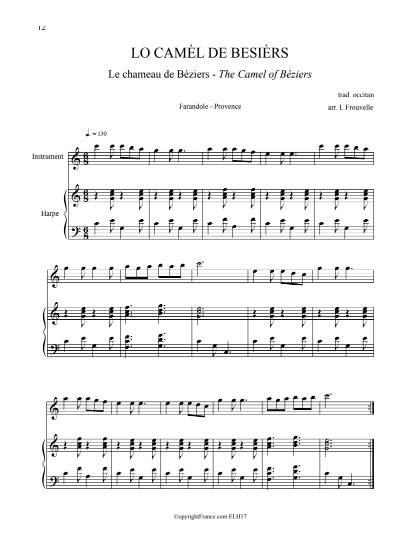Description

These dances come from the repertoire of traditional music from the South of France. When performed at balls, they are repeated in a loop, usually with little variation. Some are songs, others just dance tunes. They are usually played with local instruments such as the hurdy-gurdy, the graile (oboe), the cabrette (bagpipe), the accordion, the violin, or any other instrument that the musician will join in the fun. It was through my brother Daniel, musician and hurdy-gurdy maker, very invested in this culture, that I naturally had the idea of transcribing these dances to my instrument, the harp, because in my turn I joined the group that was playing in the village and I also wanted to make people dance. The theme of animals, a theme close to nature, with sometimes amusing titles, presents a cheerful and refreshing vision of this music through the lightness of the harp accompanying a melodic instrument (flute, oboe, violin or other…).
Two exceptions in this collection: for the Bear Dance, the origins are claimed by several regions. We will retain here that of the Pyrenees, because the bear was present there and bear trainers crisscrossed the region. Although “Le Hibou” is a Berry bourrée, it is very popular in Occitania.
These dances are based on the repertoire of traditional music from the South of France. When played at balls, they are repeated continuously, usually without variation. Some are songs; others are just dance tunes. They are usually played with local instruments such as the hurdy-gurdy, the graile (oboe), the cabrette (bagpipe), the accordion, the violin, or any other instrument that the musician brings along to play at the party. I was inspired by my brother Daniel, a musician and hurdy-gurdy maker, who is very devoted to this culture. Understandably, I transcribed these dances for my instrument, the harp, because at my turn I joined the group that played in the village and I wanted to make people dance too. The theme of animals, a theme close to nature with somewhat funny titles, presents a cheerful and refreshing view of this music through the lightness of the harp accompanying a melodic instrument (flute, oboe, violin or other …).
Two exceptions in this collection: for the Dance of the Bear, the origins are claimed by several regions. Here we will credit the Pyrenees, because the bear was present there and bear tamers roamed the region. The Owl is a bourrée from Berry (Central France).This dance is however very popular in Occitanie.
